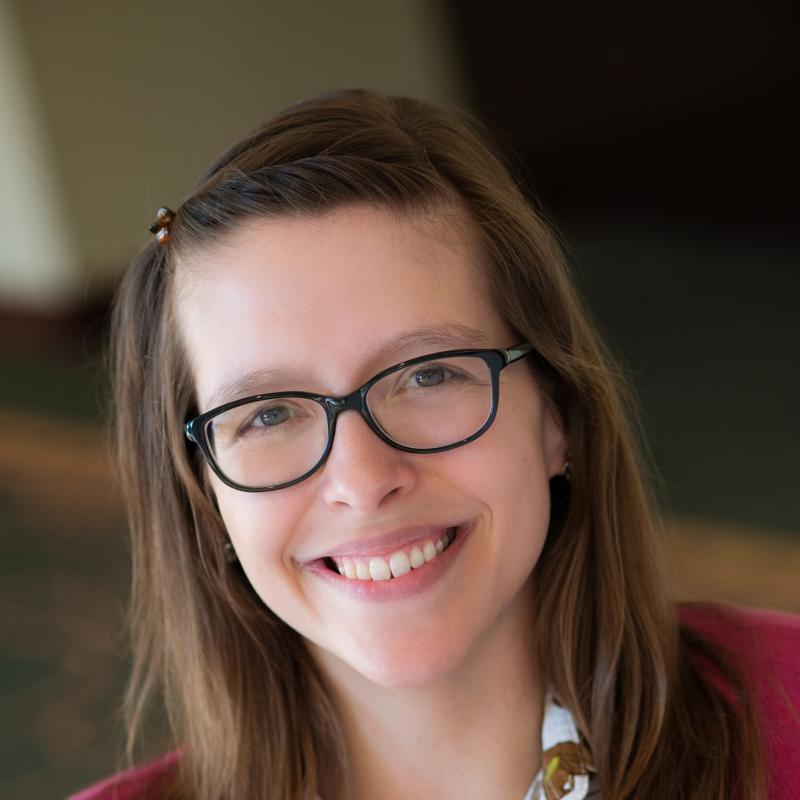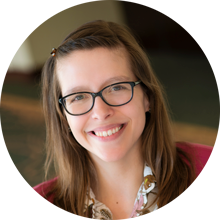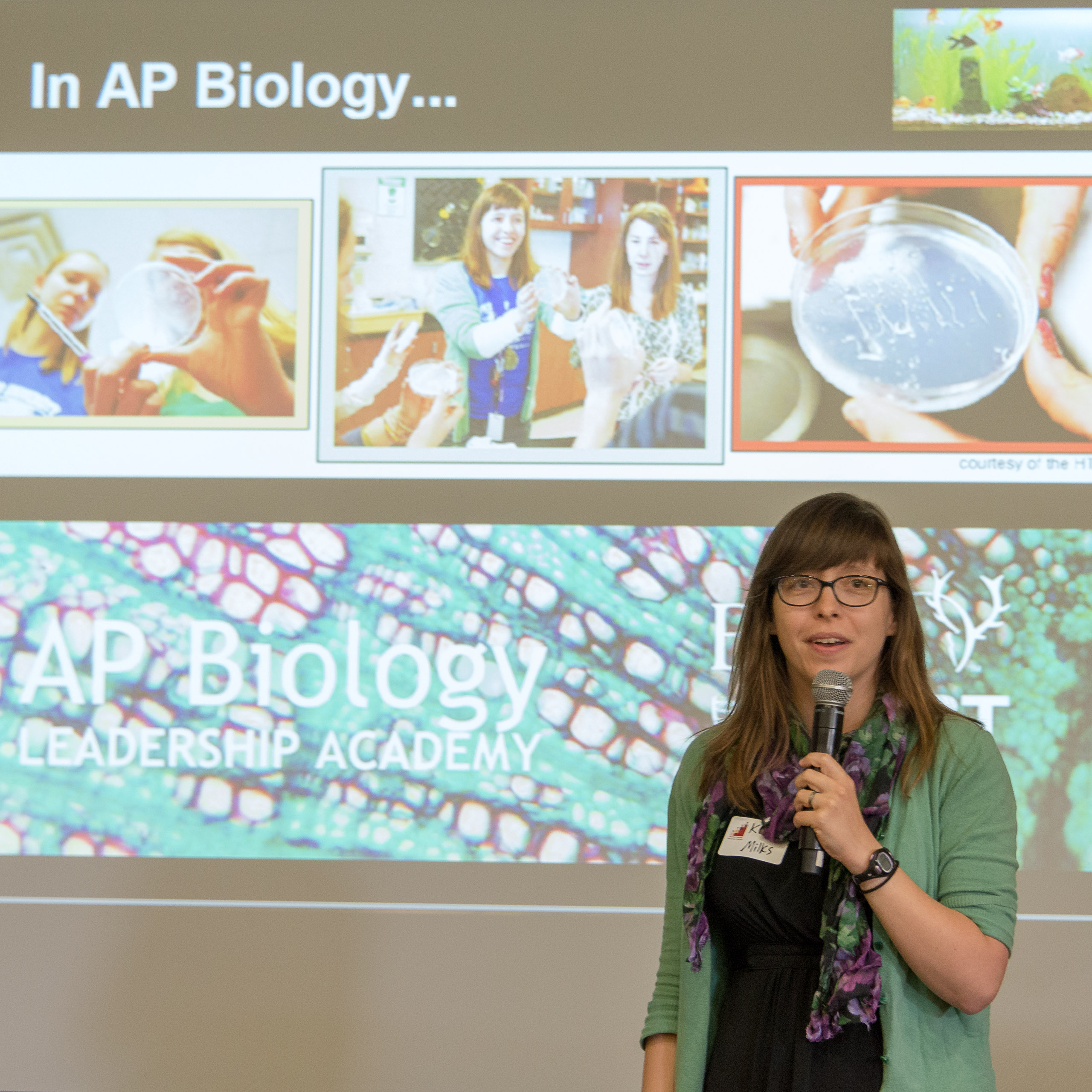
Kirstin Milks, PhD ’09, MA ’10
Bloomington High School South’s Kirstin Milks teaches with inquiry, empathy and a constant drive to improve.

Science teaching through a science lens
Bloomington High School South’s Kirstin Milks teaches with inquiry, empathy and a constant drive to improve.
By Barbara Wilcox
High school science teacher Kirstin Milks likes to say that she “was not one of my ‘toaster-oven kids’ – the kind where you come into the kitchen and the toaster oven is in pieces because the kid wants to know how it works.”
Yet she did become a scientist, earning a Stanford PhD in biochemistry before entering the Graduate School of Education and embarking on a teaching journey that has made her one of America’s most recognized young K-12 science educators.
Milks’ great contribution to the profession, say many who know her, is that she views her teaching through a lens of scientific inquiry. This habit leads her to constantly interrogate and refine her own teaching practice, to share resources, to build bridges among scientists and science educators, and to treat all her students at Indiana’s Bloomington High School South as colleagues in an ongoing voyage of discovery – with dignity, empathy and respect.
For her inspiration and commitment to high school science teaching, the GSE honors Milks with its 2017 Alumni Excellence in Education Award.
“In my 50 years in science education, Kirstin stands out as one of very few for whom science teaching was, and is, to be a fish in water,” said Jean Lythcott, pedagogy consultant at the GSE’s Center to Support Excellence in Teaching and one of dozens of people who nominated Milks for the award. Lythcott praises Milks’ evidence-based instructional strategies, which Milks shares for free on her website.
“What I really want students to do is figure out if what something someone’s saying makes sense,” said Milks, PhD ’09, MA ’10. “To look at a bum deal and say, hey, is this a bum deal? To look at an opportunity and say, this is an opportunity. And to see themselves more broadly as primary knowers and doers, as people who can help others.
“There are ways to be someone who works as a scientist and work directly with social justice. But there aren’t a whole lot of ways where you see yourself doing it every day.
“Teaching is the most direct path I know to social change.”
Milks’ own childhood was both indulged and complicated. Her late mother, a former teacher, kept a garden where Milks studied bees and ran a Girl Scout troop. Milks’ mother was also a paranoid schizophrenic.
“I tell my students that she saw and heard things that were not there,” Milks said. “Things were not OK at home. Capital ‘N’ Capital ‘O’ Not Okay. It got very spooky. But I got to go to school. … I was so grateful for that space away.”
As a Penn State freshman, Milks was rendered “on the edge of my seat” by nanoscientist Paul Weiss’s innovations in teaching first-year chemistry. The GSE’s STEP Secondary program reinforced her desire to teach innovatively and gave insight and support she still values today.
“The most valuable thing about STEP is being surrounded by a community and getting a sandbox to try new things,” Milks said. “STEP is constantly a place to prototype and to get feedback from the community of teachers that STEP has pulled in. And those relationships continue over time.
“Jeannie Lythcott taught me that you can do a lot in classrooms with simulations and models that teach important science concepts. She taught me that, one, I was still going to be a scientist in the classroom, and two, that activities in the classroom could have that inquiry lens too.”
As a student teacher, Milks worked extensively with a student she calls Rolo, an undocumented immigrant who was failing his classes. In a widely read essay, Milks explains how Rolo taught her even as she taught him. He helped Milks to set up her classroom for improved flow and refined her peer feedback techniques so students would feel more comfortable giving each other feedback.
Rolo also invented the “What’s in Your Head” exercise that Milks now uses to help students bring their identities into their learning from the first days of school. As Rolo explained to Milks, “Sometimes you come into class and things are bad [in your life]. But if you find your head and it has things that keep you going, you can remember why you are there. Remember you have got a place there—and get your work done.”
Milks is also a Senior Fellow at the Knowles Teacher Initiative, where she is an editor-in-chief of the journal Kaleidoscope: Educator Voices and Perspectives. She received the National Association of Biology Teachers’ Outstanding New Biology Teacher award in 2012 and the Yale Education Award in 2014.
“We build classroom community,” Milks said. “We build communities of practice. But the part we miss is that the students hold knowledge that we lack. Without Rolo, I wouldn’t have known that so early.
“It’s hard for the public to see teachers as holders of knowledge. It’s hard for teachers to see students as holders of knowledge.
“My ways of thinking, of making decisions, come from my scientific training. I can do many things at once. I’m good at record keeping, and I can build stories that help people learn. But I know when a kid is in my classroom that we are building something together. The kids are working on themselves. I’m working on me. And we’re working shoulder to shoulder.”
Browse Kaleidoscope, the journal of teacher writing that Milks co-edits at the Knowles Teacher Initiative.
Read Milks’ open-source AP Biology resources.
Read her advice to her AP Biology students on the last day of school.
All photos are courtesy of Kirstin Milks.
For more information about the GSE Alumni Excellence in Education Award reception, and to register for this special event, please visit the GSE’s Reunion Webpage.

